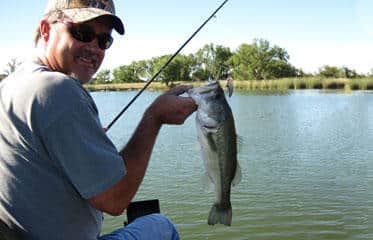Fall Bass Sampling Reveals Fishing Hotspots in Kansas

Kansas bass anglers can get a sneak peek of where the best fishing hot spots are this year. The 2013 Kansas Fishing Forecast won’t be available until next March, but this fall’s test data on largemouth bass is already in.
Each fall, Kansas fisheries biologists work long hours to sample sport fish populations in the lakes they manage. Using a variety of sampling methods, including netting and electroshocking, biologists record data, which include the number of fish taken within a unit of sampling effort, as well as the size of those fish. The information gathered helps the biologists determine the health of their fisheries, set regulations such as creel limits and length limits, and make stocking requests. Another important product of this work is the fishing forecast.
To help anglers find the kind of fishing opportunities they desire, the forecast establishes criteria for each species of sport fish. For largemouth bass, the Density Rating is the number of bass 12 inches long or longer per unit of sampling. The Preferred Rating is the number of bass in that sample longer than 15 inches, and the Lunker Rating is the number of bass longer than 20 inches. The final category based on sampling is the largest fish sampled. Using the forecast, anglers can locate lakes with high numbers of bass that will provide fast action. Or the angler may target lakes that have lower bass densities but higher numbers of lunker-sized fish.
After the 2012 sampling data was entered, the following lakes, impoundments between 10-1,200 acres in size, made the top five for largemouth bass density: 1. Miami State Fishing Lake (SFL); 2. McPherson SFL; 3. Plainville Lake; 4. Pleasanton – West Lake; and 5. Sedan – Old City Lake. Plainville Lake had the largest number of bass sampled in the Preferred Rating, and McPherson was tops with bass in the Lunker Rating. A 6.57-pound bass collected at McPherson was the largest among the top five.
For reservoirs, which are impoundments larger than 1,200 acres, the top five largemouth bass reservoirs include: 1. Keith Sebelius; 2. La Cygne; 3. Wilson; 4. Perry; and 5. Big Hill. La Cygne Reservoir, which is located in northeastern Linn County, produced the highest number of bass in the Preferred Rating, the Lunker Rating and an 8.9-pound bass caught there was easily the biggest fish collected among water-body types.
The complete 2013 Kansas Fishing Forecast, which includes all sport fish, will be produced early next year. The brochure will be available on the KDWPT website, in brochure form, and will appear in the March/April issue of Kansas Wildlife & Parks magazine.

